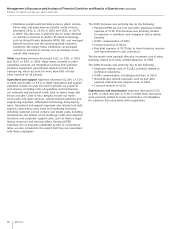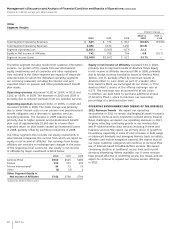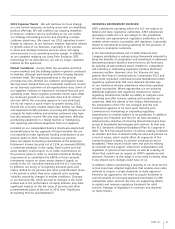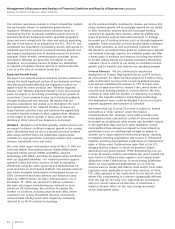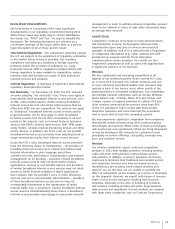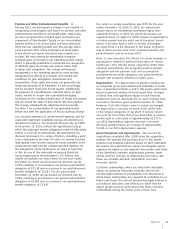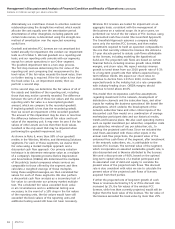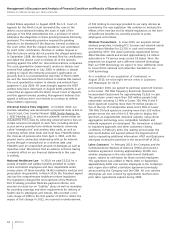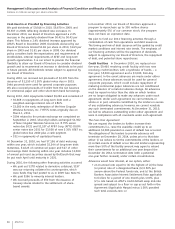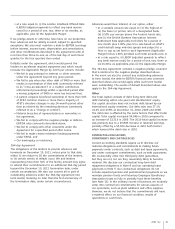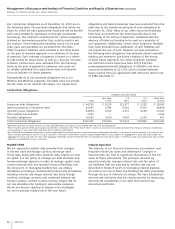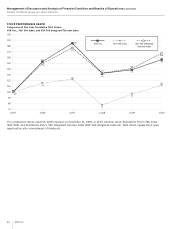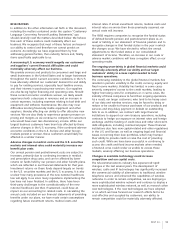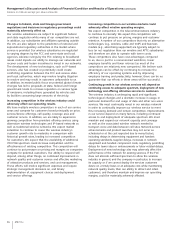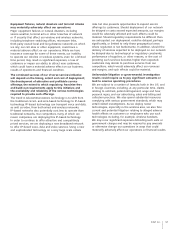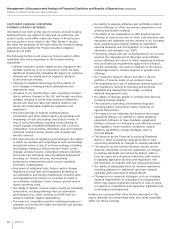AT&T Wireless 2010 Annual Report Download - page 50
Download and view the complete annual report
Please find page 50 of the 2010 AT&T Wireless annual report below. You can navigate through the pages in the report by either clicking on the pages listed below, or by using the keyword search tool below to find specific information within the annual report.
Management’s Discussion and Analysis of Financial Condition and Results of Operations (continued)
Dollars in millions except per share amounts
48 AT&T Inc.
of $92 relating to coverage provided to our early retirees as
provided by the new legislation. We continue to evaluate the
effects of the new law and its related regulations on the level
of healthcare benefits we currently provide to active
employees and retirees.
Wireless Transactions In June 2010, we acquired certain
wireless properties, including FCC licenses and network assets
from Verizon Wireless for $2,376 in cash and increased
goodwill by $937. The assets primarily represented former
Alltel Wireless assets and served approximately 1.6 million
subscribers in 79 service areas across 18 states. Since the
properties we acquired use a different network technology
than our GSM technology, we expect to incur additional costs
to convert that network and subscriber handsets to our
GSM technology.
As a condition of our acquisition of Centennial, in
August 2010, we sold eight service areas in Louisiana
and Mississippi for $273.
In December 2010, we agreed to purchase spectrum licenses
in the Lower 700 MHz frequency band from Qualcomm
Incorporated (Qualcomm) for approximately $1,925 in cash.
The spectrum covers more than 300 million people total
nationwide, including 12 MHz of Lower 700 MHz D and E
block spectrum covering more than 70 million people in
five of the top 15 metropolitan areas and 6 MHz of Lower
700 MHz D block spectrum covering more than 230 million
people across the rest of the U.S. We plan to deploy this
spectrum as supplemental downlink capacity, using carrier
aggregation technology once compatible handsets and
network equipment are developed. The transaction is subject
to regulatory approvals and other customary closing
conditions. In February 2011, the waiting period under the
Hart-Scott-Rodino Act expired without the Department of
Justice requesting additional information. AT&T and Qualcomm
anticipate closing the purchase in the second half of 2011.
Labor Contracts In February 2010, the Company and the
Communications Workers of America (CWA) announced a
tentative agreement covering approximately 30,000 core
wireline employees in the nine-state former BellSouth
region, subject to ratification by those covered employees.
This agreement was ratified in March 2010. In September,
approximately 4,000 core wireline employees in the Company’s
east region also ratified a tentative agreement previously
announced by the Company and the CWA. All core wireline
employees are now covered by agreements reached since
prior labor agreements expired during 2009.
United States appealed. In August 2008, the U.S. Court of
Appeals for the Ninth Circuit remanded the case to the
district court without deciding the issue in light of the
passage of the FISA Amendments Act, a provision of which
addresses the allegations in these pending lawsuits (immunity
provision). The immunity provision requires the pending
lawsuits to be dismissed if the Attorney General certifies to
the court either that the alleged assistance was undertaken
by court order, certification, directive or written request or
that the telecom entity did not provide the alleged assistance.
In September 2008, the Attorney General filed his certification
and asked the district court to dismiss all of the lawsuits
pending against the AT&T Inc. telecommunications companies.
The court granted the Government’s motion to dismiss and
entered final judgments in July 2009. In addition, a lawsuit
seeking to enjoin the immunity provision’s application on
grounds that it is unconstitutional was filed. In March 2009,
we and the Government filed motions to dismiss this lawsuit.
The court granted the motion to dismiss and entered final
judgment in July 2009. All cases brought against the AT&T
entities have been dismissed. In August 2009, plaintiffs in all
cases filed an appeal with the Ninth Circuit Court of Appeals,
and this appeal remains pending. Management believes this
appeal is without merit and intends to continue to defend
these matters vigorously.
Universal Service Fees Litigation In October 2010, our
wireless subsidiary was served with a purported class action in
Circuit Court, Cole County, Missouri (MBA Surety Agency, Inc.
v. AT&T Mobility, LLC), in which the plaintiffs contend that we
violated the FCC’s rules by collecting universal service fees on
certain services not subject to such fees, including Internet
access service provided over wireless handsets commonly
called “smartphones” and wireless data cards, as well as
collecting certain other state and local fees. Plaintiffs define
the class as all persons who from April 1, 2003, until the
present had a contractual relationship with us for Internet
access through a smartphone or a wireless data card.
Plaintiffs seek an unspecified amount of damages as well as
injunctive relief. We believe that an adverse outcome having
a material effect on our financial statements in this case
is unlikely.
National Healthcare Law In 2010, we paid $5,312 for a
variety of health and welfare benefits provided to certain
active and retired employees and their dependents under
various plans. Of those benefits, $4,463 related to medical and
prescription drug benefits. In March 2010, the President signed
into law the comprehensive healthcare reform legislation.
The legislation changed the tax treatment of the Medicare
Part D subsidy, provided Medicare payment reforms, and
enacted an excise tax on “Cadillac” plans as well as mandates
for providing coverage and other requirements for delivery of
health care to employees and retirees. We recorded a non-
cash charge of $995 in the first quarter of 2010 to reflect the
impact of this change. In 2011, we received a reimbursement


